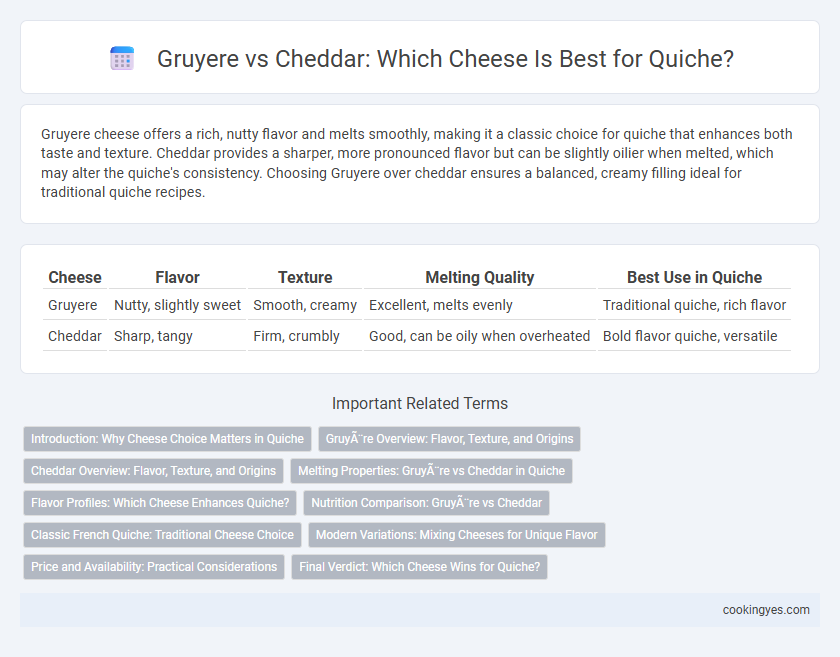Gruyere cheese offers a rich, nutty flavor and melts smoothly, making it a classic choice for quiche that enhances both taste and texture. Cheddar provides a sharper, more pronounced flavor but can be slightly oilier when melted, which may alter the quiche's consistency. Choosing Gruyere over cheddar ensures a balanced, creamy filling ideal for traditional quiche recipes.
Table of Comparison
| Cheese | Flavor | Texture | Melting Quality | Best Use in Quiche |
|---|---|---|---|---|
| Gruyere | Nutty, slightly sweet | Smooth, creamy | Excellent, melts evenly | Traditional quiche, rich flavor |
| Cheddar | Sharp, tangy | Firm, crumbly | Good, can be oily when overheated | Bold flavor quiche, versatile |
Introduction: Why Cheese Choice Matters in Quiche
Cheese choice in quiche significantly influences texture and flavor, making it essential to select the right variety. Gruyere offers a creamy, nutty taste that melts smoothly, enhancing the custard's richness, while cheddar provides a sharper, tangier profile with a firmer texture. Understanding these characteristics ensures the quiche achieves the desired balance of savory depth and creamy consistency.
Gruyère Overview: Flavor, Texture, and Origins
Gruyere cheese offers a complex, nutty flavor and a smooth, creamy texture that melts beautifully in quiche, enhancing its richness without overpowering other ingredients. Originating from the Gruyeres region in Switzerland, this semi-hard cheese is aged for several months, developing a distinct savory profile ideal for classic quiche Lorraine recipes. Its superior melting qualities and balanced taste make Gruyere a preferred choice over cheddar, which tends to be sharper and more crumbly.
Cheddar Overview: Flavor, Texture, and Origins
Cheddar cheese, originating from England's Somerset region, offers a sharp, tangy flavor that intensifies with age, making it a robust choice for quiche. Its firm and slightly crumbly texture melts well, creating a creamy consistency that complements eggs without overpowering other ingredients. Compared to Gruyere's nutty and mellow profile, cheddar brings a bolder taste and a richer, more savory depth to quiche recipes.
Melting Properties: Gruyère vs Cheddar in Quiche
Gruyere melts smoothly and evenly, creating a creamy, rich texture ideal for quiche filling, while cheddar tends to release more oil and can become grainy when heated. The high moisture content in Gruyere enhances its meltability, contributing to a silkier custard, whereas aged cheddar's lower moisture leads to a firmer texture that may separate. Choosing Gruyere over cheddar ensures a more cohesive, tender quiche with superior melt properties.
Flavor Profiles: Which Cheese Enhances Quiche?
Gruyere offers a nutty, slightly sweet flavor with a creamy texture that melts perfectly in quiche, enhancing its savory richness. Cheddar has a sharper, more pronounced taste that can dominate the delicate balance of the quiche filling. For a traditional and well-rounded flavor profile, Gruyere is the preferred cheese to elevate the overall taste of quiche.
Nutrition Comparison: Gruyère vs Cheddar
Gruyere cheese contains approximately 413 calories, 33 grams of fat, and 30 grams of protein per 100 grams, offering a rich source of calcium and vitamin A, which supports bone health and vision. Cheddar cheese typically has about 402 calories, 33 grams of fat, and 25 grams of protein per 100 grams, providing a slightly lower protein content but comparable levels of calcium and vitamin B12 that contribute to energy metabolism and red blood cell formation. Both cheeses are nutrient-dense options for quiche, but Gruyere's higher protein and vitamin A content may offer added benefits for those seeking more nutrient diversity in their diet.
Classic French Quiche: Traditional Cheese Choice
Gruyere is the classic cheese used in traditional French quiche, prized for its creamy texture and nutty, slightly sweet flavor that melts beautifully into the custard filling. Unlike cheddar, which is sharper and can overpower the delicate balance of a quiche, Gruyere complements ingredients like eggs, cream, and bacon without dominating the dish. This cheese's smooth melting properties and subtle complexity make it the preferred choice for achieving an authentic, rich French quiche experience.
Modern Variations: Mixing Cheeses for Unique Flavor
Modern quiche variations often mix Gruyere and cheddar to create a unique flavor profile, combining Gruyere's nutty, creamy texture with cheddar's sharp, tangy bite. Blending these cheeses enhances the quiche's richness and depth, appealing to diverse palates and adding complexity to classic recipes. This fusion allows for customizable taste experiences, making quiche adaptable to contemporary culinary trends.
Price and Availability: Practical Considerations
Gruyere cheese, known for its nutty flavor, tends to be more expensive and less widely available in some regions compared to cheddar. Cheddar offers a cost-effective and easily accessible alternative without compromising too much on taste, making it a practical choice for everyday quiche recipes. Price and availability often make cheddar the preferred option for home cooks seeking convenience and budget-friendly ingredients.
Final Verdict: Which Cheese Wins for Quiche?
Gruyere is the preferred cheese for quiche due to its smooth melting quality and rich, nutty flavor that perfectly complements the creamy custard base. Cheddar offers a sharper, tangier taste but can become oily and overpower the dish's delicate balance. For a classic, well-textured quiche, Gruyere delivers superior flavor integration and a silkier mouthfeel, making it the winning choice.
Gruyère vs cheddar for quiche cheese Infographic

 cookingyes.com
cookingyes.com